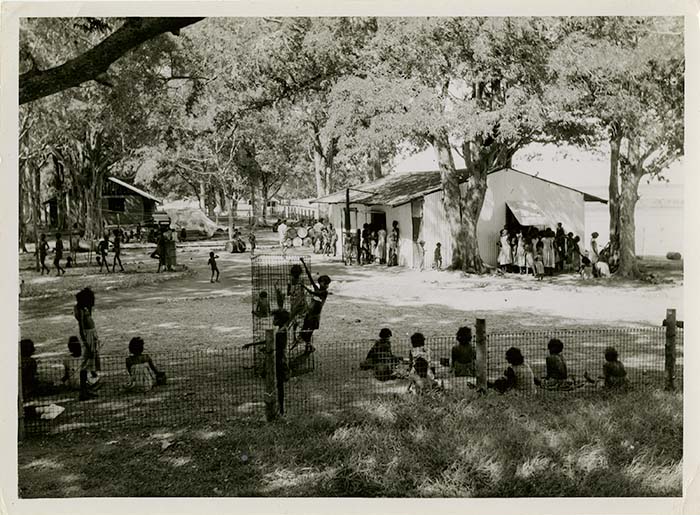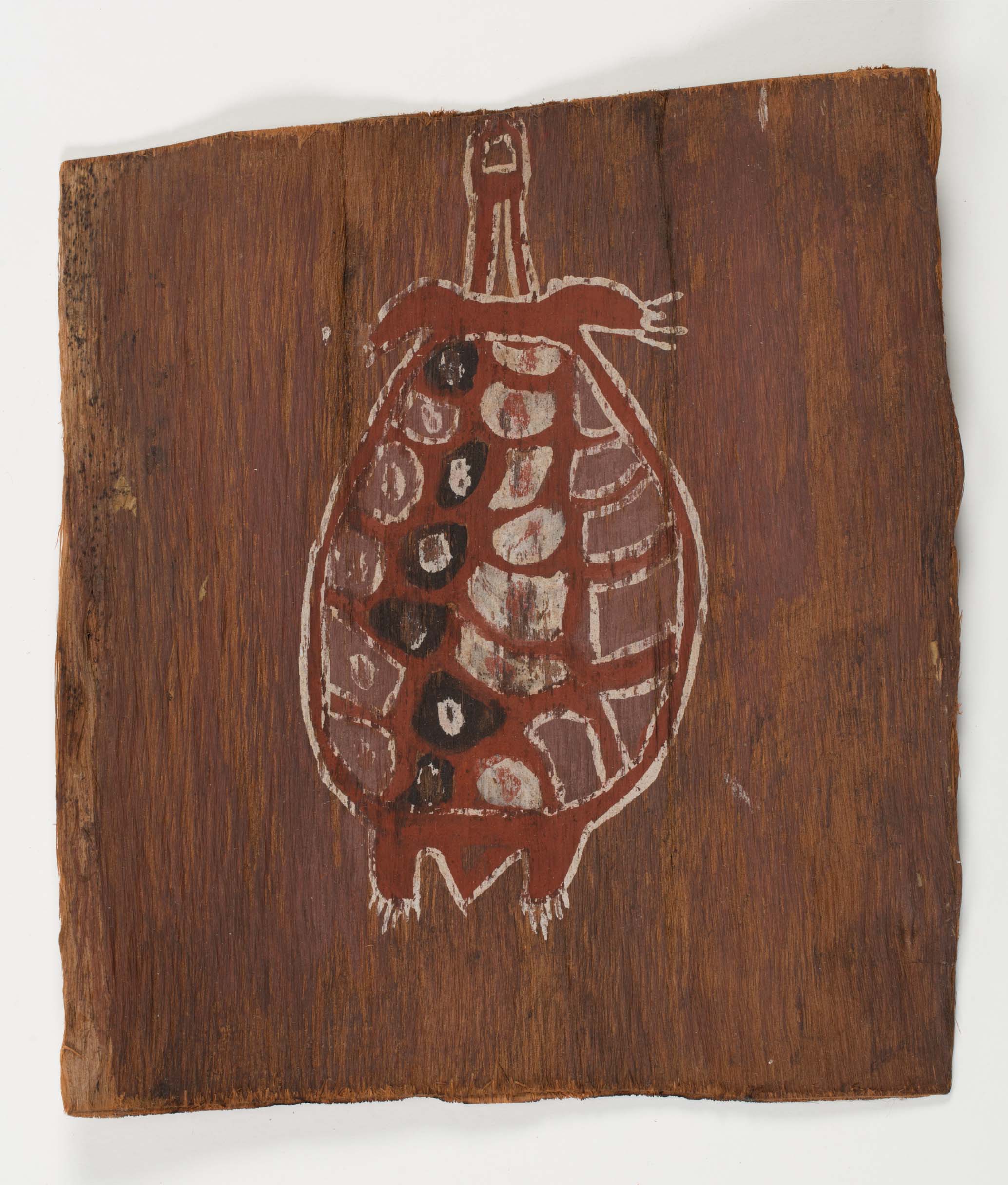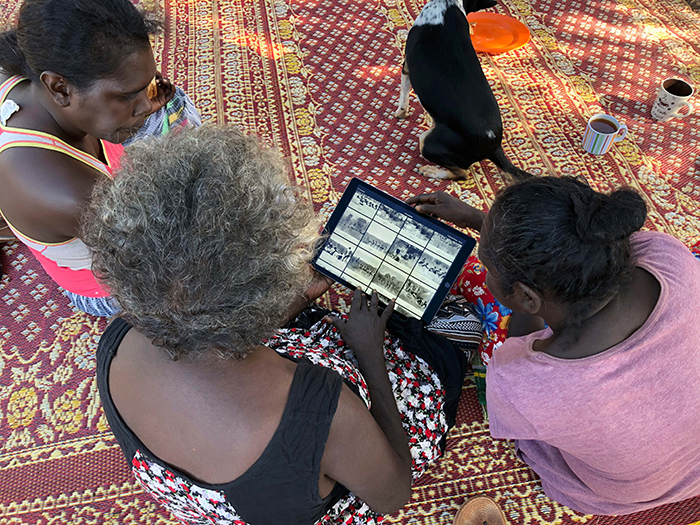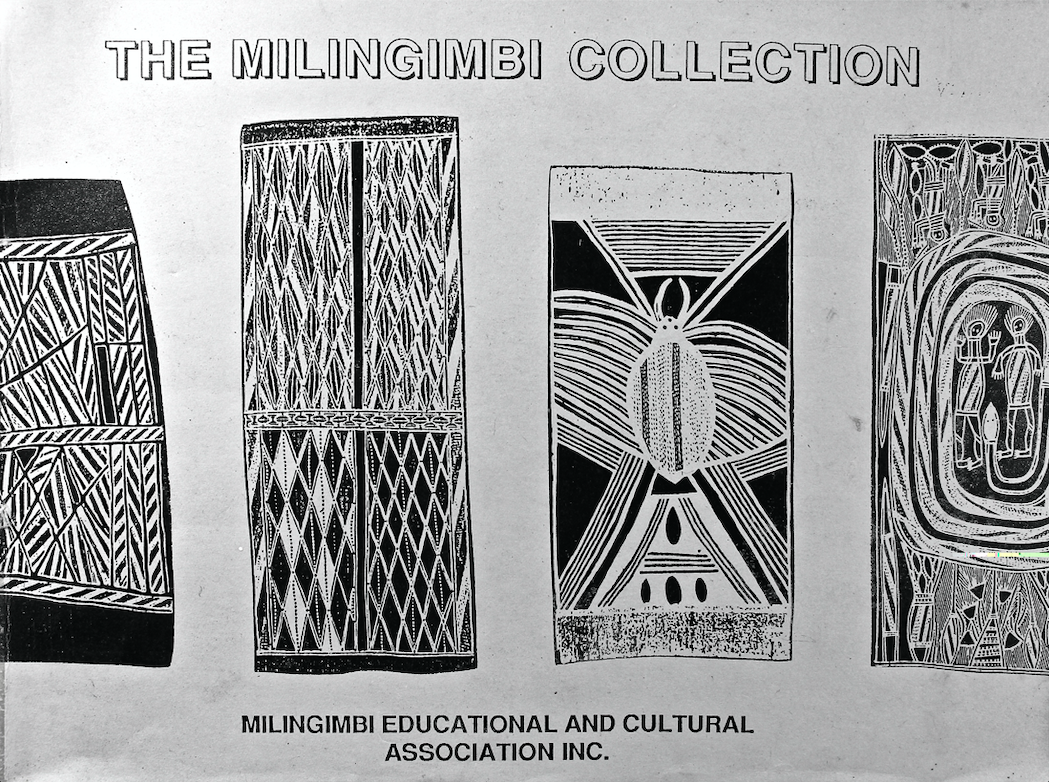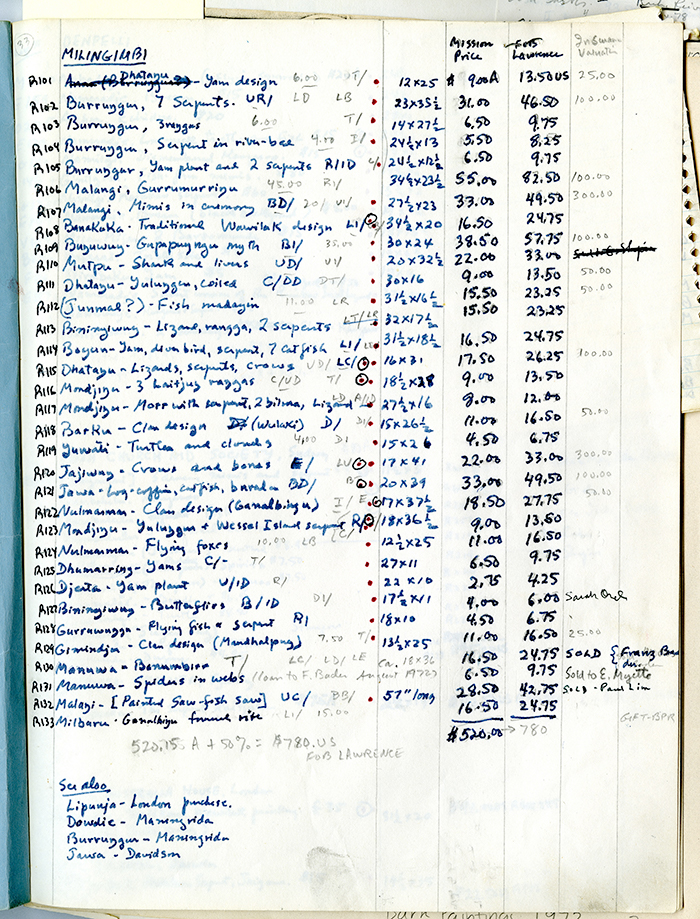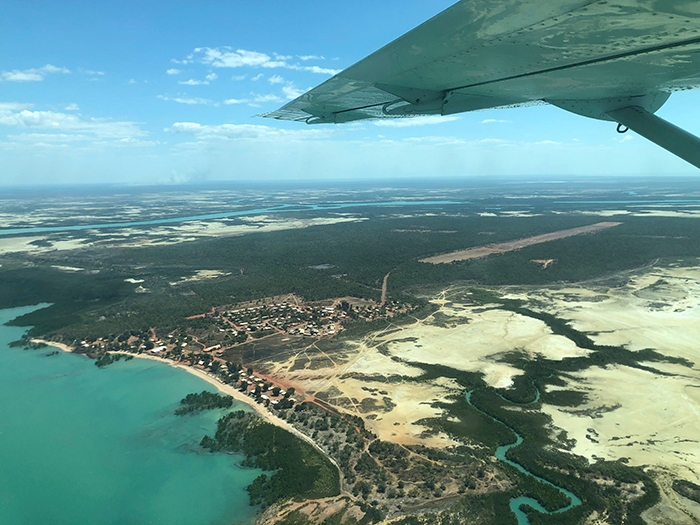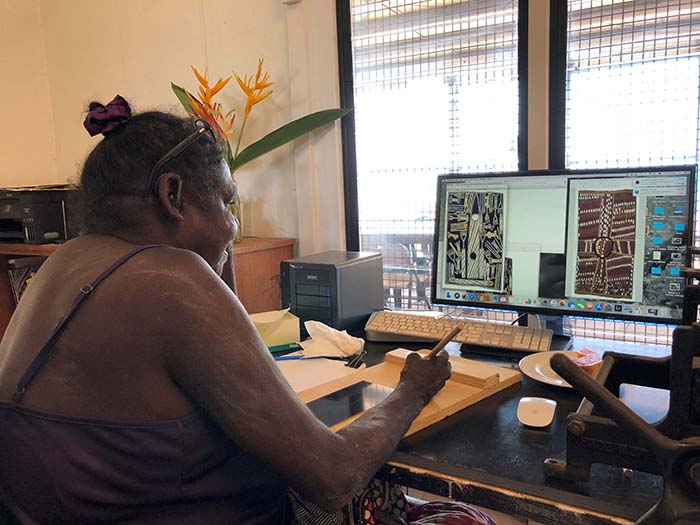History
Napurruŋ ḏilkurruwurru mala gan yaka gäna guyaŋanha. Yurr Yolŋu mala walal gan ŋunhi nhäŋal dhuwal wäŋa bala nhinanhan bala wäŋayaŋalnha. Bala walal malthurr ŋurukiyi djalkiriwnha ga romgun ḏilkurruwurruw mala.
Milingimbi Landscape
RM Berndt
Image courtesy of Berndt Museum [2021-1-64]
Djalkiri
Yolŋu have been living, hunting and dreaming here since the beginning of time, when the waŋarr (creation ancestors) first travelled through, creating land and giving language and law to all. This is when the djalkiri (foundations) were first established, which our forefathers have followed since. We follow in their footsteps.
International Links
For a long time Yolŋu were visited by and traded with large groups of people from places like Makassar and Timor in present day Indonesia, and Japan and China. Yolŋu still carry this history through their dhäwu (oral histories), matha (language), manikay (ceremonial songs) and raŋga (ceremonial objects). Balanda (non-Indigenous people) have also uncovered artefacts of these international links, such as 800-year-old coins from Africa found near Elcho Island.
The Macassans, who stayed for long periods while they harvested trepang, developed especially strong ties with Yolŋu. These links are still remembered today and expressed through shared language, in ceremony and material culture. Visible examples of this are the many loan words and objects like lipalipa (dugout canoe) and bamutuka (smoking pipe). Here in Milingimbi our art centre is shaded by 100-year-old djambaŋ (tamarind) trees brought by the Macassans.
Ḏawiḏi rigging sail with Roy Rewa and family, Milingimbi
Image courtesy of David Morgan
Milingimbi Mission Store
11.03.02.21a – Edward L. Ruhe Archive
Image courtesy of Kluge Ruhe Collection
Mission Times
The religious missions were the first formal and permanent incursions by Europeans into Arnhem Land. Milingimbi was chosen as the first Methodist Mission in 1923 and soon Yolŋu from all over Central Arnhem Land were gathered here. The mission history is both celebrated and criticised, but it is clear that it has had a lasting effect on Yolŋu through changes to their lifestyles, migration patterns and ceremonial practices. One notable development was the sale of Yolŋu objects and artworks through the Mission. Some early missionaries were also prolific collectors and photographers, and this material now forms some of the most significant collections held in museums and galleries around the world.
The Beginning of Collaboration
The academic world became increasingly interested in Yolŋu and their culture in the first half of the 20th century and from the beginning, Milingimbi was the pre-eminent destination for their field work. While the convention of the time was to treat Aboriginal material culture as curios and artefacts not worthy of detailed documentation, this cohort of researchers were some of the first to document names of artists, clan affiliations and the stories and ceremonies they represented or were affiliated with. While the ideas and language of many of the researchers was a product of their time, they were among the first to establish a pattern of close cooperation between Yolŋu and Balanda that has become a feature of the collecting history in Milingimbi.
The material collected by these researchers now make up a significant portion of the Yolŋu cultural heritage kept in collecting institutions. Today Yolŋu are reclaiming this material through their own academic study and curatorial practices. The Djalkiri Keeping Place supports this work that seeks to clarify and correct existing documentation while also inserting Yolŋu voices and authority into the narrative.
Minhala/Nyaŋura (Long-necked turtle)
One of the first bark paintings ever collected in NE Arnhem land
ETP.2020 – Collected by Warner 1927-29
Image courtesy of Chau Chak Museum
Susan Balbunga, Prescilla Gapirrawuy and Roslyn Bayumbula viewing collection photos taken around Milingimbi during WWII.
Image courtesy of Milingimbi Arts and Culture
WWII
WWII saw big changes to North Australia. Both Darwin and Milingimbi were bombed from the air and many Yolŋu had their first exposure to Western technologies of war including explosives, war planes and machine guns. Donald Thompson, whose previous work in Arnhem Land in the 30’s advocated strongly for Yolŋu sovereignty, led a Yolŋu reconnaissance unit to patrol the vast stretch of coast along Arnhem Land. Several key Yolŋu artists from Milingimbi joined this force.
Post-War Period
During the post-war period, Milingimbi became known as an epicenter of art excellence. In the 60’s and 70’s a shift towards more local community autonomy meant there was more infrastructure to support the overall cultural health of the community, including movements like both ways education and subsequent land and sea rights claims in the region.
Riding this momentum, the Milingimbi Educational and Cultural Association (MECA) was set up by David McClay and David Morgan in collaboration with many key artists and senior elders of the Milingimbi community. Through the guidence of these knowledgable elders, their mission was to acquire and preserve significant art works and objects representing the clans settled in Milingimbi for the benefit of the community itself. After decades of being the source community for esteemed collections of Yolŋu art and material culture around the world, the MECA collection represented a chance for the community to finally own its own artistic and cultural resource. The collection was misappropriated in the early 1980’s and after a long court battled legal ownership was returned to Yolŋu. This collection numbers over 250 pieces and is temporarily housed at Museum and Art Gallery of NT. It is the hope of the Art Centre and our Yolŋu board that this unique collection will one day return to its home in Milingimbi.
The MECA Collection
Image courtesy of David Morgan
Ed Ruhe bark inventory 1972. Edward L. Ruhe Archive.
Image courtesy of Kluge Ruhe Collection
From the Museum to the Gallery
Building on the progress of preceding decades, Indigenous art and material cultural started to appear in art galleries much more regularly as part of a growing understanding of Indigenous art as having artistic merits as well as cultural. While this meant greater numbers of non-Indigenous Australians had a chance to access and appreciate Yolŋu and other Indigenous art and the knowledge held within, the creators and their communities were often silent witnesses in this process. Exhibitions were still based on a logic of extraction and curation was usually the sole remit of non-Indigenous ‘experts’, while if Indigenous communities were included in this process their involvement would rarely be acknowledged publicly or through payment. While here in Milingimbi collaborative collection practices pioneered the acknowledgment of artists, their artistic merit and their authorship, when these works were sold or exhibited this information was not always included. It was only during this period did these practices start to be followed widely.
Self-Governance
In 2001 Milingimbi Art and Culture was registered as a community-owned, not-for-profit Indigenous corporation with an all-Yolŋu board. This moment marked a significant change in governance, with Yolŋu finally being able to decide the direction and practices of the art centre. The art centre model lent itself to supporting community aspirations, upholding the cultural health of the community whilst also creating economic opportunities for the community. Milingimbi Art and Culture took up residence in a historical mud brick building built by missionaries and Yolŋu elders. The floor was physically stamped flat by the forbearers of today’s generations, meaning all those that enter the art centre are able to walk in the footsteps of our forebearers.
Milingimbi from the air
Image courtesy by Milingimbi Art and Culture
Margaret Rarru – Ŋärra Body Paint Design
Image courtesy of Milingimbi Art and Culture
Rarru wins NATSI
In 2007 Milingimbi Art and Culture Senior Artist and Garrawurra senior clan authority Margaret Rarru won the National Aboriginal & Torres Straight Islander Art Awards Bark Painting award for her painting Ŋärra Body Paint Design. The painting depicts gapu milminydjarrk (sacred waterholes) at her homeland of Gärriyak.
Makarraṯa
Over the last 10 years some collecting institutions that house historic Milingimbi collections have started a discussion with the art centre and the Milingimbi community about how they can improve their practices when working with and supporting the aspirations of the community. This shift in practice seeks to ensure mutual benefit for both collecting institutions and the community through their engagement with the art centre. A makarraṯa, or peace-making ceremony, was held in 2016 to bring people and collecting institutions together and acknowledge this ongoing process. Milingimbi Art and Culture hopes that these efforts can be sustained into the future and looks forward to working closer with institutions to realise a fairer and more equitable way forward.
Harry Makarrwaḻa and others, Makarraṯa in Milingimbi
HP99.1 – taken by WL Warner 1927-29
Image courtesy of Chau Chak Museum
Lorrianne Manamana engaging with the Djalkiri Collections. Etching for the Djalkiri Memorial 2020
Image courtesy of Milingimbi Arts and Culture
Djalkiri Keeping Place
The Djalkiri Keeping Place hopes to continue the work of Yolŋu artists and elders that have since passed by supporting community access to their own documented material culture. The Keeping Place is embedded in the Art Centre’s daily practice, meaning the boundaries between the historic and contemporary are proudly subverted everyday as our artists reach into the Keeping Place Collections to follow in the footsteps of their ancestors.



